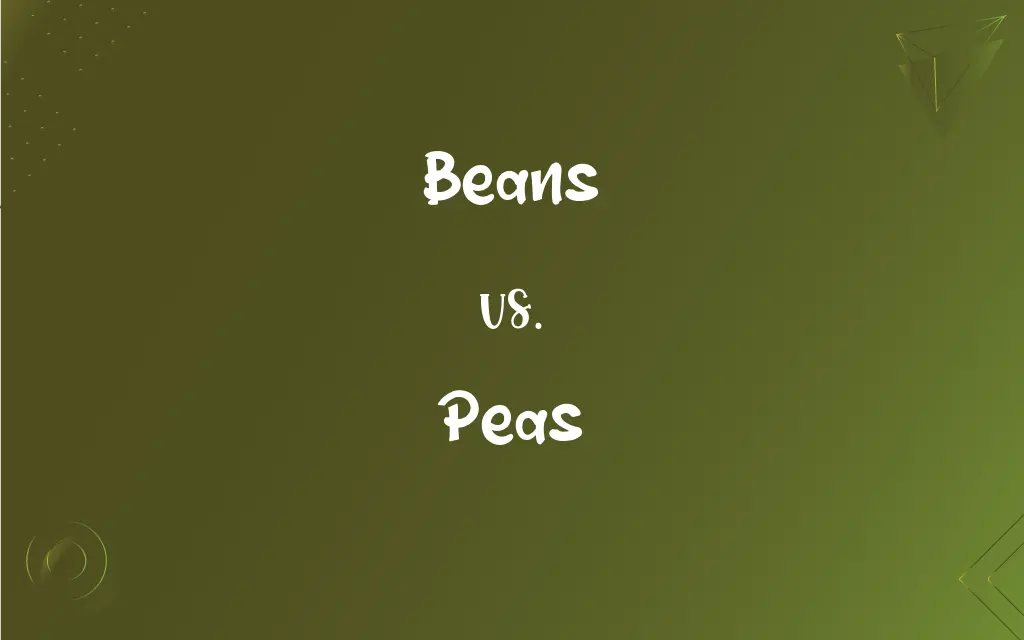Beans vs. Peas: What's the Difference?
Edited by Janet White || By Harlon Moss || Updated on October 20, 2023
Beans are seeds from the Fabaceae family, while peas are seeds from specific leguminous plants within this family.

Key Differences
Beans are a broad term that encompasses a wide variety of legumes from the Fabaceae family. They come in many sizes, shapes, and colors and are consumed in numerous stages of growth. Peas, on the other hand, are specifically seeds from plants of the genus Pisum. While both beans and peas belong to the same family, beans have a more generalized meaning compared to the specificity of peas.
Beans are known for their rich protein and fiber content and are essential in many global cuisines. Peas, as a subset of legumes, also offer a variety of nutrients and have a sweet taste, making them distinct from many other beans. Both have been cultivated for thousands of years, showcasing their importance in human nutrition.
Different varieties of beans include black beans, kidney beans, and lima beans, each with its unique flavor and culinary use. Peas, on the other hand, primarily revolve around green peas, snow peas, and snap peas. Both beans and peas are versatile in cooking, suitable for both main courses and side dishes.
Beans are often dried for long-term storage and require soaking before cooking. This method helps in reducing cooking time and enhancing digestibility. Peas, especially green peas, are generally consumed fresh or frozen, and have a shorter cooking time compared to many beans. Both beans and peas, however, can be canned for convenience.
Both beans and peas play significant roles in vegetarian and vegan diets due to their high protein content. Beans often act as meat substitutes in various dishes, while peas are commonly used in soups, salads, and as a vegetable side. Despite their differences, both beans and peas are cherished for their nutritional value and versatility in the kitchen.
ADVERTISEMENT
Comparison Chart
Definition
Seeds from the Fabaceae family.
Seeds from plants of the genus Pisum.
Varieties
Black beans, kidney beans, lima beans, etc.
Green peas, snow peas, snap peas, etc.
Taste
Varies, often earthy and hearty.
Generally sweet.
Storage
Often dried and require soaking before use.
Consumed fresh, frozen, or canned.
Common Use
Main courses, soups, salads, and sides.
Soups, salads, vegetable sides, and stews.
ADVERTISEMENT
Beans and Peas Definitions
Beans
Commonly dried for long-term storage.
She soaked the beans overnight before cooking.
Peas
Small spherical seeds or seed-pods from the Pisum plant.
He sprinkled some fresh peas into the stir-fry.
Beans
A major source of protein and fiber in many cuisines.
Beans are essential in vegetarian diets.
Peas
Can be consumed fresh, frozen, or canned.
She bought a bag of frozen peas for the recipe.
Beans
Edible seeds from various plants of the Fabaceae family.
She added some black beans to the salad.
Peas
Known for their sweet taste and green color.
The green peas added a vibrant hue to the dish.
Beans
Can be green, red, black, or white in color.
The recipe calls for red beans.
Peas
Frequently used in soups, stews, and salads.
The pea soup was heartwarming and delicious.
Beans
Often ground to make flours or pastes in various dishes.
Bean paste is a key ingredient in this dish.
Peas
Also ground to make pea protein powder.
Pea protein is a popular choice for vegans.
Beans
Any of various twining herbs of the genus Phaseolus in the pea family, native to the Americas, having leaves with three leaflets and variously colored flowers, and widely cultivated for their edible pods and seeds.
Peas
A member of the pea family.
Beans
A seed or pod of any of these plants.
FAQs
Are peas considered beans?
No, peas are a specific type of legume within the Fabaceae family, while beans are a broader category.
Are beans and peas good sources of protein?
Yes, both beans and peas are rich in protein.
What family do beans belong to?
Beans belong to the Fabaceae family.
Can both beans and peas be consumed as sprouts?
Yes, both beans and peas can be sprouted and consumed.
Can beans be green in color?
Yes, some beans like green beans are green, similar to green peas.
Are beans and peas gluten-free?
Yes, both beans and peas are naturally gluten-free.
Can beans and peas be grown in home gardens?
Absolutely, both beans and peas are popular choices for home gardening.
Do beans and peas have similar nutritional profiles?
While both are nutritious, their exact profiles differ; beans are often higher in protein, while peas might have more vitamins.
Which has a wider variety, beans or peas?
Beans have a wider variety compared to peas.
Are beans and peas used in vegan diets?
Yes, both beans and peas are staples in vegan diets due to their protein content.
Do beans need to be soaked before cooking?
Many dried beans require soaking before cooking to reduce cooking time and enhance digestibility.
Which is sweeter, beans or peas?
Peas generally have a sweeter taste compared to most beans.
Can you name a popular dish with beans?
Chili con carne is a popular dish with beans.
Are all beans edible?
While many beans are edible, some require proper cooking to neutralize toxins, and a few are inedible.
Are there any inedible peas?
Most peas from the genus Pisum are edible, but it's always best to consume well-known, cultivated varieties.
How long do beans and peas take to cook?
Cooking time varies; dried beans often take longer, while fresh or frozen peas cook relatively quickly.
Are beans and peas high in fiber?
Yes, both beans and peas are rich sources of dietary fiber.
How are peas generally stored?
Peas are generally consumed fresh, frozen, or canned.
Are beans and peas considered whole grains?
No, beans and peas are legumes, not whole grains.
What's a common dish with peas?
Pea soup is a common dish made with peas.
About Author
Written by
Harlon MossHarlon is a seasoned quality moderator and accomplished content writer for Difference Wiki. An alumnus of the prestigious University of California, he earned his degree in Computer Science. Leveraging his academic background, Harlon brings a meticulous and informed perspective to his work, ensuring content accuracy and excellence.
Edited by
Janet WhiteJanet White has been an esteemed writer and blogger for Difference Wiki. Holding a Master's degree in Science and Medical Journalism from the prestigious Boston University, she has consistently demonstrated her expertise and passion for her field. When she's not immersed in her work, Janet relishes her time exercising, delving into a good book, and cherishing moments with friends and family.































































